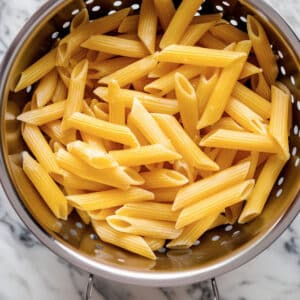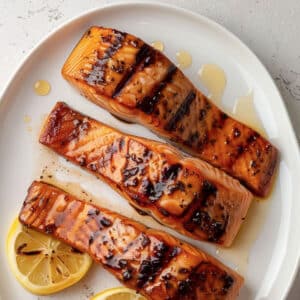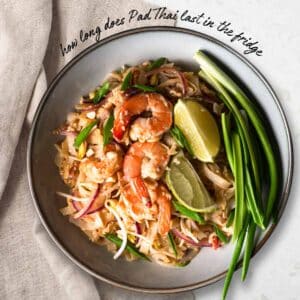Sushi rice vs sticky rice? Aren't they both alike when it comes to viscous consistency? It's a lingering question that leads to many people's confusion, including those novices in cooking.
The two are popular rice variants that you'll find in the market and are sticky. However, that's where the similarities end. Both belong to the same type of grains but are somewhat different.
This article introduces each rice type to you and compares both variants. So, please read on.
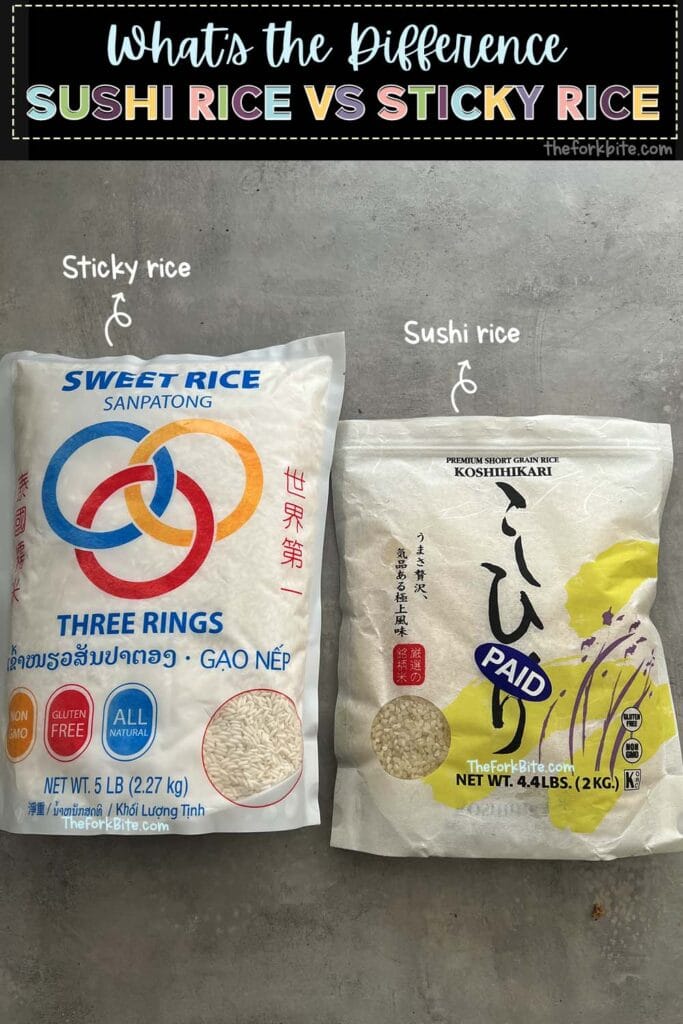
Difference between sushi rice and sticky rice
Considering the similarities in textures, some folks assume that both can be switchable with one another.
And why? Because both of them are sticky, an attribute you don't find in other rice varieties.
While you may use short or medium rice grains for making Japanese rice, sushi rice in the USA is mainly short-grain. While Asian stores usually sell rice packets labeled "sushi rice," the Japanese do not call the rice sushi rice.
To them, it is plain rice eaten with vegetables of the season and can also be used to make sushi. After seasoning the rice with vinegar, the Japanese call it sushi rice.
It shows that shop owners name the rice' sushi rice' more for marketing reasons and to let sushi lovers know they can use it to make their favorite dish.
For Sushi rice
Sushi rice has a sticky or gluey consistency complemented by adding sugar, rice vinegar, and salt. Its natural stickiness is paramount in holding the sushi rice together.
Unfortunately, not many people realize there's another type of "sticky rice" that is diverse. Adding to the confusion, they named "sushi rice" sticky rice.
Read:

For Sticky rice
This sticky rice grows predominantly in East and Southeast Asian countries. Its unique characteristics include its sweetness and opaque or chalky look grains, compared to Japanese grains that are short and translucent.
The main distinguishing feature of sticky rice is its sweetness with just the right amount of saccharinity.
Moreover, sticky rice, also known as glutinous rice or sweet rice, is high in amylopectin starch and low in amylose starch. It practically sticks to your hands. That's how "glutinous rice" gets its name. However, don't get fooled by the name because glutinous rice doesn't contain gluten.
Read: How to Reheat Sticky Rice
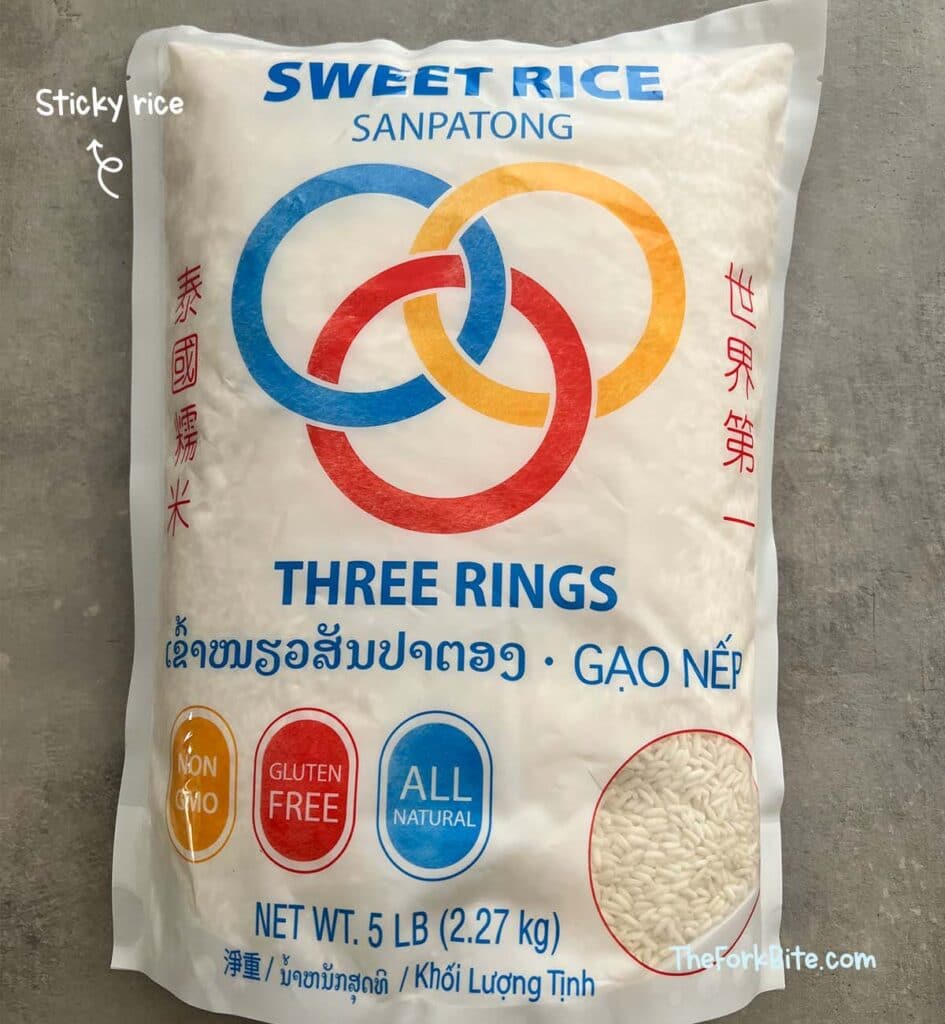
The starches amylose and amylopectin exist in most rice grains, and their percentage determines how sticky the cooked rice is. For example, long rice grains contain more amylase (about 19-23%). So when cooked, you end up with fluffy rice.
On the contrary, short grains commonly used to make sushi contain less amylose (only about 12-19%), while sticky ones have only 1% amylase.
Sushi rice vs. sticky rice
1 Preparation for cooking
One of the distinctions between these two is gleaning from how they are prepared. Sushi rice refers to the preparation method, whereas sticky rice is an actual type of rice.
2 Usage flexibility
In essence, you can make sushi by using Japanese short-grain rice. However, you can use both long and short-grain variants to make sticky rice dishes.
3 Types of meals rice is used
While you can use both types of rice to make sushi, you can use sticky rice for cooking various other meals. You can use sticky rice for cooking dishes like peanut or mango sticky rice, pearl meatballs, steamed lotus leaf wraps, dumplings, sweets, and duck stuffing.
4 Calories and nutrition
Sticky rice is healthier because sushi rice has added sugar and salt. While sticky rice, primarily brown rice, has no added salt or sugar.
Comparison table: Sushi Rice vs Sticky Rice
| Sushi Rice | Sticky Rice |
|---|---|
| Appears glossy and is quite sticky, but not as sticky as the sticky rice. | Is very sticky |
| The rice is rinsed prior processing to remove the outer starch coating. | The rice is not rinsed prior processing, retaining most of the outer starch coating. |
| Used most notably for making sushi, as the texture is very suitable for easy rolling in seaweeds. | Used in some Chinese recipes such as for making Lo Mei kai, Mochi, dumpling, and Mango sticky rice. |
What is sticky rice?
Sticky rice is a unique rice variant like jasmine rice and is more popular because of its texture or consistency. Generally, all rice variants contain amylopectin and amylase starches, determining the final grain texture.
As sticky rice has high amylopectin levels and low amylase levels, its grains stick together while cooking. So while it feels and looks like sushi rice, it is a lot stickier in texture.
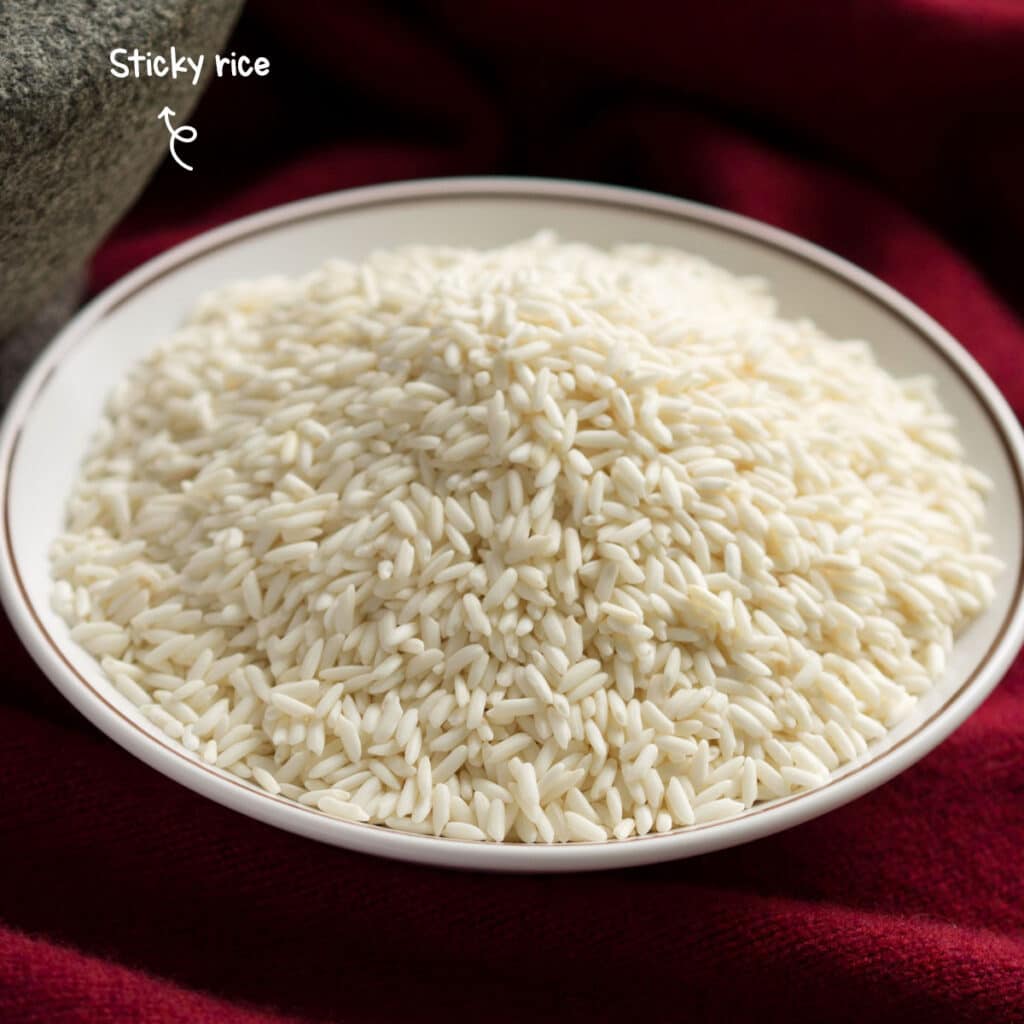
These rice variants are also known as sweet or glutinous rice. However, just because it's called glutinous doesn't imply the rice contains gluten. On the contrary, this is gluten-free rice.
It gets the name because the rice is chewy and clumps together while cooking. Besides, sticky rice costs more, or about double, the regular white rice cost.
Buy Thai rice when shopping for sticky rice.
As sticky rice is different from regular rice, you should get acquainted with what to look for when shopping. It is marked as "glutinous rice" or "Thai rice" most of the time.
It's also better to stick to buying Thai brands like Rose or Three Rings to get the most authentic sticky rice. However, with quality come costs. So it's not surprising that this specialty rice is more expensive than regular rice, sometimes costing more than double the price.
You may wonder why you can't use plain white rice to make sticky rice. It's all because of the structure of rice. All rice variants contain two starch types- amylase and amylopectin.
Regular rice has more amylase content (about 19-23%), while sticky rice has only one percent amylase. And it is this low amylase content that helps sticky rice stay together when cooked.
The secret to making sticky rice in a rice cooker
It is customary for some folks to steam the sticky rice, which is a lengthy process for some people. However, there is an efficient way to cook sticky rice faster with the help of a rice cooker.
While rice cookers help cook your rice quicker, you should refrain from using its preset programs to cook sticky rice. Sure, these preset features can cook the rice but they mostly yield the wrong texture.
Subsequently, it would be best to soak the rice before cooking in small appliances.
Here's the trick for getting the best sticky rice using a rice cooker
Here's how you can make perfectly cooked sticky rice in a rice cooker:
Step 1
Grab two cups of glutinous rice and pour them into the rice cooker.
Step 2
Now here goes the little trick. Stir in 2 cups of water. Gently mix.
Step 3
Leave the rice in the water for 40 minutes or a maximum of four hours at best. When you do the soaking process, you let the rice become pliable before cooking. In consequence, it benefits the rice to obtain its signature texture.
Step 4
After the soaking process, mix in ½ teaspoon of salt. Switch the "on" button of the rice cooker.
Step 5
Once the rice is ready, allow simmering further for another 5 minutes and your rice is ready to serve.
Step 6
And that's it! All that's left is to take pleasure in eating your sticky rice. Any unconsumed rice is best stored in the fridge for 2 to 3 days.
Useful tips for cooking sticky rice
Soaking rice is crucial, so don't forget to soak the rice!!
This is crucial because, unlike other rice varieties, you must soak the rice for 30 to 40 minutes before cooking. Saturating the rice gives the kernel core time to absorb moisture.
The good news is that the latest and newer rice cookers come with a programmed soaking time which can cost you an arm and a leg. But mostly, they don't have that kind of feature.
- Lessen the water slightly (about 10%) when adding rice to a new harvest crop.
- It's better to stick to one rice brand as various brands require different amounts of water.
- It is imperative to soak rice in water for 30 to 40 minutes, drain well and then add sufficient water using the 1-to-1 ratio. Don't worry if you don't have a measuring cup. You can use a mug to measure the rice and water volume.
What is sushi rice?
Sushi rice is cooked Japanese short rice grains flavored with a splash of rice vinegar, sugar, salt, and Kombu or kelp. It's called sushi-meshi (鮨飯), Shari (シャリ). Or su-meshi (酢飯) in Japanese.
Sushi or vinegar-flavored rice is used to make all types of sushi. However, the problem is that many rice companies out of Japan call Japanese short-grains "sushi rice."
This labeling makes people think that the rice is only for making sushi rice while you can use it for making regular steamed rice and other rice dishes.
The only main thing to do when using Japanese short rice grains for making sushi is to cook and mix them with the proper vinegar-based seasoning.
Where can I buy Japanese short-grain or sushi rice?
Japanese short rice or sushi rice is commonly available in most grocery stores, or you can order it online, like Amazon. The common brands are Nishiki and Kokuho Rose, while premium brands are Tamaki Gold and Tamanishiki Super Premium Short Grain Rice.
Why do you need vinegar for sushi rice?
Sushi was literally specified as "sour flavor" when traced back to its inception. Japanese people used to swaddle fish in fermented rice for storage and tossed the rice before consuming the fish.
However, sometime between the 13th and 15th centuries, the Japanese stopped using fermented rice and worked to increase its shelf life by adding vinegar.
They realized that the added vinegar improved the rice flavor and started consuming the rice with the fish. This was how and when the sushi dish started.
While you don't have to worry about fish spoiling these days, thanks to the refrigerator, vinegar-flavored rice or sushi is here to stay.
Tips for making the perfect sushi rice
I love my rice cooker; I use it regularly if I need to make rice. It simplifies the process allowing me to cook rice consistently to achieve those fluffy and sticky grains.
Grab these ingredients:
- 2 cups Japanese short-grain rice
- 1.8 cups of water
- a strip of Kombu or kelp - (not required yet highly suggested). Integrating this ingredient is the untold secret to achieving the best-seasoned sushi rice.
For Seasoned-vinegar:
- 4 tablespoon Rice vinegar
- 2 teaspoon Salt
- 2 tablespoon Sugar
Step-by-step instructions:
Step 1
The first thing to do is wash the rice until cloudy water turns clear. Use a strainer or colander to empty the washing water and put the rice in a rice cooker.
Step 2
Add the measured cup of water and drop a strip of Kombu (or kelp) for that umami kick. Now, switch the "on" button to start cooking the rice.
Step 3
While the rice is cooking, prepare the sushi vinegar seasoning. Pour rice vinegar, sugar, and salt into a heat-proof bowl. Mix well and zap it in the microwave at 10 seconds intervals or until the sugar melts or fuses.
Step 4
Take away the kelp strip once the sushi rice is ready (if you use one). Then, reposition the rice on a baking tray lined with parchment paper. Or, if you have "hangiri" available, dampen the wooden tub with water and wipe away excess water with a paper towel.
Step 5
While the rice is piping hot, make the slicing motion using a rice paddle instead of stirring in circles. Drizzle the sushi rice with seasoned vinegar. Fan the rice to cool it down.
Step 6
Be sure to make the slicing or cutting motion rather than mashing while ventilating the rice with a fan to let it cool at room temperature.
Step 7
To prevent the rice from drying, use a damp paper towel or kitchen towel to shield the tray/wooden tub until use. Don't put it in the fridge.
Cooking tips for Sushi rice
Here are a few valuable tips to remember and Implement while cooking sushi rice:
1 Pick the correct rice variety
We often aim to achieve that typical Japanese standard for cooking sushi rice. Ergo, using Japanese short-grain rice is the best option.
Compared to long-grain rice, jasmine rice, or other variants, Japanese short-grain rice has a distinct flavor and consistency. Apart from that, Japanese rice contains more moisture, and its unusual viscosity and texture make it an excellent choice for making authentic sushi.
While you will find various Japanese rice brands in stores, the most popular first-grade brands include Japan, Toyama, Prefecture, and Koshinikari from California.
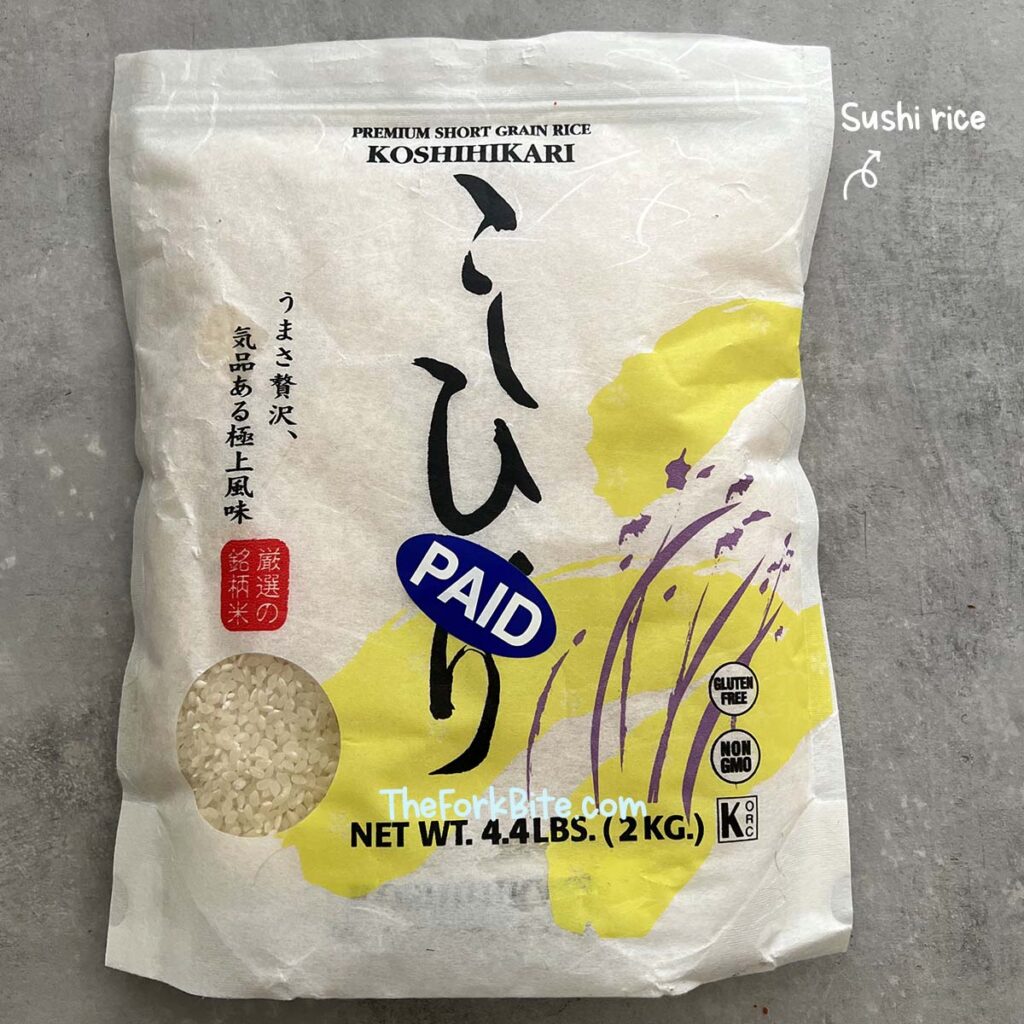
2 Always rinse and soak rice before cooking.
This is an essential tip to follow while cooking sushi rice. It is necessary to wash and rinse it a few times before cooking to remove all the amylopectin starch from the rice surface before cooking it.
Now soak the freshly rinsed rice for a minimum of 30 minutes to 2 hours before cooking it. This step helps give the rice grains a better and more improved texture.
3 Add Kombu to enhance the flavor.
There are numerous benefits and reasons for the Japanese to use Kombu or dried kelp in their dishes. Though this is optional, I believe adding this ingredient makes a difference. It makes it more authentic when cooking aromatic sushi rice.
It's left to you to decide, but if you ask me, I like doing so because Kombu infuses a subtle umami fragrance and taste into the rice.
4 Add less water than required.
Yes, you must add 10% less water while cooking sushi rice because the sushi vinegar seasoning of salt, vinegar, and sugar you will be adding contains some moisture.
5 Create your own sushi vinegar.
You always have to add sushi vinegar for seasoning to cook sushi rice. The right proportion and blend of sugar, salt, and rice vinegar give your sushi rice the perfect salt, sweet and sour taste.
However, to get the right taste, add mild-flavored rice vinegar and not just any vinegar. The flavor will not be suitable or the same if you add strong vinegar.
When you dissolve the sugar, add the ingredients into a bowl and heat it in a microwave. Alternatively, you can use a bottle of seasoned sushi vinegar or sushizu (すし酢) to save time.
6 Add vinegar and let the rice cool.
Once the rice is cooked and ready to eat, transfer it to a big bowl, salad bowl, hangiri, or sushi oke. First, moisten the surface to prevent the rice from sticking to it. Alternatively, you can transfer the rice to a baking sheet lined with parchment paper.
The purpose of doing this is so that the rice quickly cools down. You can use an electric fan or the hand-held fan uchiwa (うちわ) to quicken the cooling process.
With the rice transferred into a bowl or baking sheet, drizzle rice vinegar over the rice before it gets cool. Then using a rice paddle, start mixing the rice in a slicing motion to prevent smashing or making it mushy.
You will have cool and glossy sushi rice with proper fanning and slicing methods.
7 Use a damp towel to cover the rice.
Do not leave the rice as it is after mixing. Cover the rice with a damp paper towel or kitchen cloth to prevent it from getting dry. Keep it at room temperature if you won't be using it immediately. Don't put it in the refrigerator.


